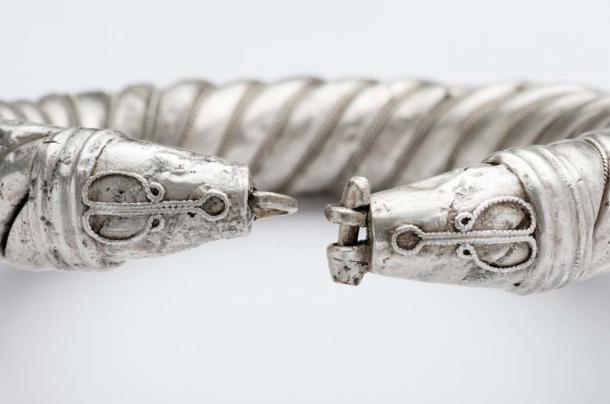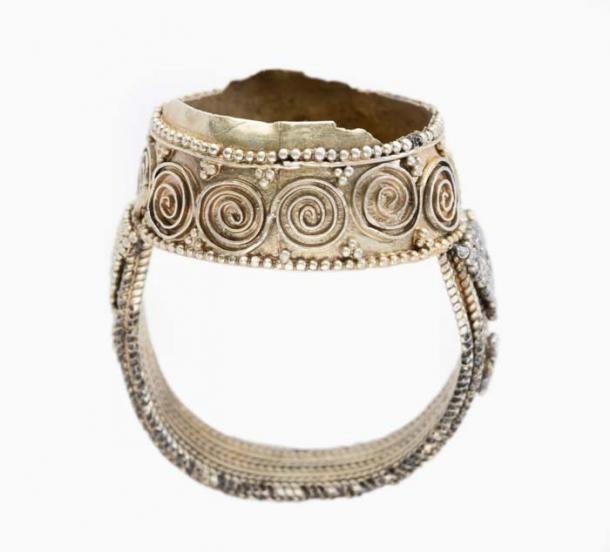The Archaeological and Ethnological Museum of Córdoba has opened an entrancing new exhibit that is turning heads. For the first time ever, members of the public and press are getting a close-up look at the marvelous Amarguilla Treasure, a vast assemblage of precious jewelry which can be classified as one of the most remarkable discoveries ever unearthed in the Andalusia region of southern Spain. The Amarguilla Treasure, which is named after an estate near Córdoba where it was allegedly dug up, represents “the 11 th century’s best collection of jewelry.” So says Alberto Canto , a professor of archaeology at the Autonomous University of Madrid who has helped catalog and evaluate the 623-piece treasure hoard.

The museum’s poster for its spectacular exhibition of the Amarguilla Treasure. ( Archaeological and Ethnological Museum of Córdoba )
The Amarguilla Treasure Hoard Is Huge And Inspiring
The Amarguilla Treasure exhibit features 98 pieces made from gold, silver, or gilded silver. That includes pendants, hairpins, chains, necklaces, rings, and dress ornaments in various states of repair. Most notable are four golden wrist bracelets and anklets, and a large golden pendant that contains a delicately designed inset of the Star of David.
The Amarguilla hoard also includes 14 quartz and rock crystals beads, four cylindrical pink coral beads, 31 glass stones in multiple colors, and 476 river pearls, the latter of which have never been found in any other excavated Andalusian jewelry hoard.
“It is simply spectacular,” said Canto, who is one of the world’s leading experts on Al-Andalus, the name given to the Iberian Peninsula (modern Spain and Portugal) by the Muslim kingdom that ruled the area from the 8th to the early 11 th centuries AD. “I have not seen anything like it. It is impossible to know who hid it or to whom it belonged, because it lacks coins, but most likely it belonged to a Jewish individual, since there is a Star of David among the pieces. It also looks like a bride’s trousseau [personal items collected for a wedding], because it includes many pieces that would be attached to tunics.”
Over the decades there have been sixteen jewelry hoards excavated in the Andalusian region of southern Spain. The Amarguilla Treasure is the most bountiful and beautiful and is destined to become a permanent fixture in the on-display collection at the Archaeological and Ethnological Museum, once the current temporary exhibit closes on June 6, 2021 AD.
But the Amarguilla Treasure’s size and quality isn’t the only thing that distinguishes it from similar discoveries. Unlike other hoards, this one wasn’t unearthed from the ground by archaeologists. Instead, it was recovered by the Spanish national police, following a criminal investigation sparked by “black-market” social media images.

A closeup of one of the priceless silver bracelets or anklets in the collection. ( Archaeological and Ethnological Museum of Córdoba )
An Illicit Scheme Exposed And Stunning Treasure Discovered
No one had any idea that the Amarguilla Treasure existed, until an archaeologist from the Córdoba area discovered images of several high-quality pieces of jewelry that had been uploaded to a social media site in 2020.
Archaeologists know all about the thriving antiquities black market , which now operates primarily online. Consequently, they are always on the alert for suspicious activity surrounding previously unknown and unidentified artifacts.
Acting quickly, the archaeologist who found the pictures contacted the Spanish national police, who immediately opened an investigation to trace the photographs to its source.
It didn’t take long for law enforcement officers to find the individual who was in possession of the jewelry. Pressed to disclose the location where he’d found the treasure, this person took the police to the La Amarguilla estate near the town of Baena , where he claimed to have accidentally discovered the jewelry collection while digging around in the ground for undisclosed reasons.
The man’s story was unconvincing, and archaeologists don’t believe he actually found the treasure where he said he did. Nevertheless, they were delighted to recover this fantastic collection of elaborately designed and manufactured jewelry, which was turned over to the Andalusian regional government before being passed on to the Archaeological and Ethnological Museum for further analysis.

One of the many rings that make up the Amarguilla Treasure collection. ( Archaeological and Ethnological Museum of Córdoba )
Buried To Save It The Treasure Was Lost In The Confusion
Unfortunately, it seems the police were not able to find the collection before a section of it was sold off.
“All Umayyad Caliphate treasures include coins, which suggests that, in this case, they have been sold because these kinds of pieces sell easily, while the jewelry does not,” Canto explained. “No antique dealer or collector would buy them [the jewelry pieces]. The lack of coins makes it difficult for us to establish exactly when it was buried. But I am leaning towards the beginning of the 11th century.”
If this treasure was indeed buried in the early 11 th century, its owner may have done so in response to the chaos and uncertainty that reigned in the region.
The Muslim Caliphate of Córdoba, which ruled over the Iberian Peninsula (Al-Andalus) and a large swath of North Africa on behalf of the Umayyad Dynasty at that time, was torn asunder by a 20-year civil war that broke out in the year 1009 AD. Eventually, the fractured central authority was replaced by multiple competing Muslim principalities, all of which pursued their own agendas as they strove to preserve their independence.
In this tumultuous environment, there was great fear among the populace, whose lives and livelihoods were threatened by the perpetual instability and its potentially catastrophic consequences. In response to the danger, the Jewish man or family who owned the jewelry collection may have decided to bury it for a while, to keep it from being stolen by thieves.
Presumably, the man or family planned to return to retrieve their treasured items at some point. But fate obviously intervened, and it is logical to assume that the owners were either imprisoned, killed, or forced to flee before they could reclaim their valuables.
The true story of what happened to the original owners of the Amarguilla Treasure collection will never be known. But the treasure they were so anxious to preserve has been safely recovered and is now on display for all to see, and we can assume it would have given them comfort to know the items they cherished so much did not remain lost forever.
Top image: An extremely fine gold pendant of the Star of David that highlights the superb craftsmanship of the jewelry contained in the Amarguilla Treasure collection . Source: Archaeological and Ethnological Museum of Córdoba
By Nathan Falde
Related posts:
Views: 0
 RSS Feed
RSS Feed

















 March 19th, 2021
March 19th, 2021  Awake Goy
Awake Goy  Posted in
Posted in  Tags:
Tags: 
















